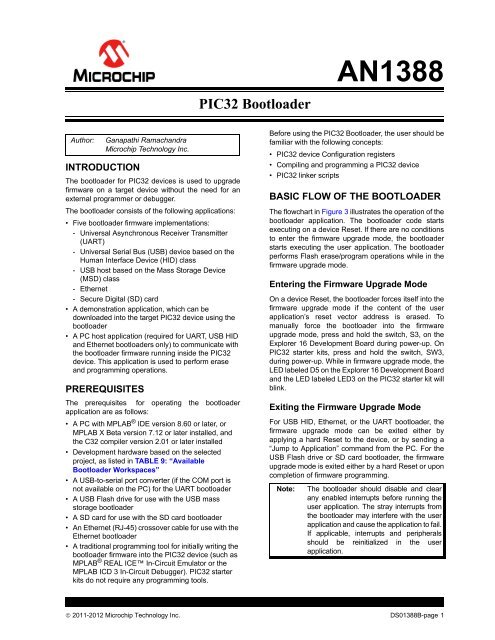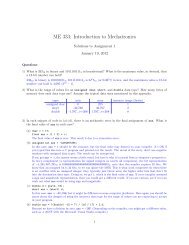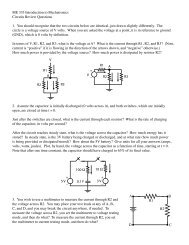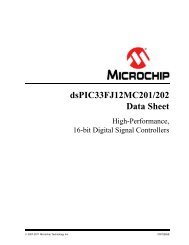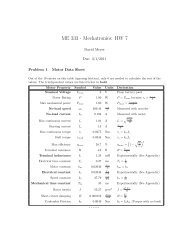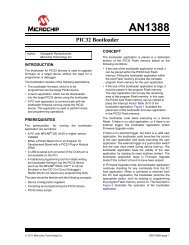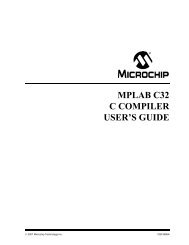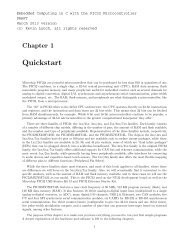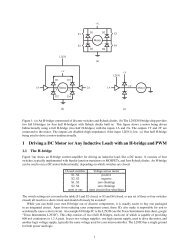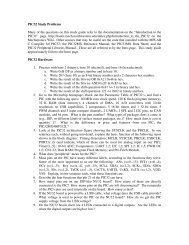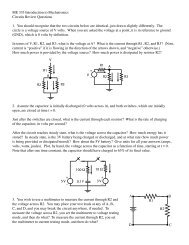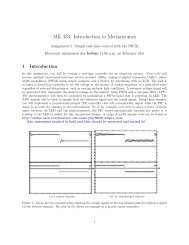AN1388 â PIC32 Bootloader - Microchip
AN1388 â PIC32 Bootloader - Microchip
AN1388 â PIC32 Bootloader - Microchip
You also want an ePaper? Increase the reach of your titles
YUMPU automatically turns print PDFs into web optimized ePapers that Google loves.
<strong>AN1388</strong><strong>PIC32</strong> <strong>Bootloader</strong>Author:INTRODUCTIONGanapathi Ramachandra<strong>Microchip</strong> Technology Inc.The bootloader for <strong>PIC32</strong> devices is used to upgradefirmware on a target device without the need for anexternal programmer or debugger.The bootloader consists of the following applications:• Five bootloader firmware implementations:- Universal Asynchronous Receiver Transmitter(UART)- Universal Serial Bus (USB) device based on theHuman Interface Device (HID) class- USB host based on the Mass Storage Device(MSD) class- Ethernet- Secure Digital (SD) card• A demonstration application, which can bedownloaded into the target <strong>PIC32</strong> device using thebootloader• A PC host application (required for UART, USB HIDand Ethernet bootloaders only) to communicate withthe bootloader firmware running inside the <strong>PIC32</strong>device. This application is used to perform eraseand programming operations.PREREQUISITESThe prerequisites for operating the bootloaderapplication are as follows:• A PC with MPLAB ® IDE version 8.60 or later, orMPLAB X Beta version 7.12 or later installed, andthe C32 compiler version 2.01 or later installed• Development hardware based on the selectedproject, as listed in TABLE 9: “Available<strong>Bootloader</strong> Workspaces”• A USB-to-serial port converter (if the COM port isnot available on the PC) for the UART bootloader• A USB Flash drive for use with the USB massstorage bootloader• A SD card for use with the SD card bootloader• An Ethernet (RJ-45) crossover cable for use with theEthernet bootloader• A traditional programming tool for initially writing thebootloader firmware into the <strong>PIC32</strong> device (such asMPLAB ® REAL ICE In-Circuit Emulator or theMPLAB ICD 3 In-Circuit Debugger). <strong>PIC32</strong> starterkits do not require any programming tools.Before using the <strong>PIC32</strong> <strong>Bootloader</strong>, the user should befamiliar with the following concepts:• <strong>PIC32</strong> device Configuration registers• Compiling and programming a <strong>PIC32</strong> device• <strong>PIC32</strong> linker scriptsBASIC FLOW OF THE BOOTLOADERThe flowchart in Figure 3 illustrates the operation of thebootloader application. The bootloader code startsexecuting on a device Reset. If there are no conditionsto enter the firmware upgrade mode, the bootloaderstarts executing the user application. The bootloaderperforms Flash erase/program operations while in thefirmware upgrade mode.Entering the Firmware Upgrade ModeOn a device Reset, the bootloader forces itself into thefirmware upgrade mode if the content of the userapplication’s reset vector address is erased. Tomanually force the bootloader into the firmwareupgrade mode, press and hold the switch, S3, on theExplorer 16 Development Board during power-up. On<strong>PIC32</strong> starter kits, press and hold the switch, SW3,during power-up. While in firmware upgrade mode, theLED labeled D5 on the Explorer 16 Development Boardand the LED labeled LED3 on the <strong>PIC32</strong> starter kit willblink.Exiting the Firmware Upgrade ModeFor USB HID, Ethernet, or the UART bootloader, thefirmware upgrade mode can be exited either byapplying a hard Reset to the device, or by sending a“Jump to Application” command from the PC. For theUSB Flash drive or SD card bootloader, the firmwareupgrade mode is exited either by a hard Reset or uponcompletion of firmware programming.Note:The bootloader should disable and clearany enabled interrupts before running theuser application. The stray interrupts fromthe bootloader may interfere with the userapplication and cause the application to fail.If applicable, interrupts and peripheralsshould be reinitialized in the userapplication.© 2011-2012 <strong>Microchip</strong> Technology Inc. DS01388B-page 1
<strong>AN1388</strong>BOOTLOADER PLACEMENT INMEMORYFigure 1 illustrates two schemes for the bootloaderplacement based on the size of the bootloader.<strong>Bootloader</strong>s that are smaller in size are placed withinthe <strong>PIC32</strong> boot Flash memory. Fitting the bootloaderapplication within the boot Flash memory provides thecomplete program Flash memory for the userapplication.In the case of bootloaders that exceed the size of<strong>PIC32</strong> boot Flash, the bootloader is split into two parts.The Interrupt Vector Table (IVT) and the C start-upcode are placed in boot Flash, and the remainingportion of the bootloader is placed inside the programFlash.FIGURE 1:BOOTLOADER PLACEMENT0x9FC02FEF0x9FC02FEF<strong>Bootloader</strong>Code and IVTBoot Flash (1)<strong>Bootloader</strong> IVT0x9FC000000x9FC00000Reserved0x9D07FFFFReserved0x9D07FFFFUser ApplicationCode and IVTProgram Flash (1)User ApplicationCode and IVT<strong>Bootloader</strong> placement inboot Flash memory0x9D000000<strong>Bootloader</strong>Code<strong>Bootloader</strong> placement inprogram Flash memory0x9D000000Note 1:The size of the boot Flash memory and program Flash memory depends on the particular device. Referto the “Memory Organization” chapter in the specific device data sheet for more information.DS01388B-page 2© 2011-2012 <strong>Microchip</strong> Technology Inc.
<strong>AN1388</strong>IMPLEMENTATION OVERVIEW(UART, USB HID, AND ETHERNET)The bootloader application is implemented using aframework. The bootloader firmware communicateswith the PC host application by using a predefinedcommunication protocol. The bootloader frameworkprovides Application Programming Interface (API)functions to handle the protocol related frames from thePC application. For more information on thecommunication protocol, see Appendix B:“<strong>Bootloader</strong> Communication Protocol (UART, USBHID, and Ethernet)”.FRAMEWORK (UART, USB HID, ANDETHERNET)Figure 2 illustrates the bootloader architecture. Thebootloader framework provides several API functions,which can be called by the bootloader application andthe transport layer. The bootloader framework assiststhe user to easily modify the bootloader application toadapt to different requirements.FIGURE 2:Transport LayerBOOTLOADERARCHITECTURE (UART,USB HID, AND ETHERNET)<strong>Bootloader</strong> ApplicationFramework ServicesUSBEthernetUARTThe <strong>Bootloader</strong>.c file contains the bootloaderapplication code. This file includes the bootloaderfunctionality, and is illustrated in Figure 3.FIGURE 3:BOOTLOADER OPERATIONResetDevice ResetInitialize System ClockCheck TriggerTrigger ExistsNo TriggerCheck for ValidApplicationNo Valid ApplicationValid ApplicationOn Command Jump to Application/Program CompletionFirmware Upgrade ModeDisable and Clear Interrupts(If Any)Erase/Program/VerifyRun Application© 2011-2012 <strong>Microchip</strong> Technology Inc. DS01388B-page 3
<strong>AN1388</strong>The Framework.c file contains the frameworkfunctions. The framework handles the communicationprotocol frames, and executes commands receivedfrom the PC host application.The transport layer files, Uart.c andUsb_HID_tasks.c, include the functionality fortransmitting and receiving the raw bytes to and from thePC host application.Table 1 lists the API functions provided by theframework.TABLE 1:FRAMEWORK API DESCRIPTIONS (UART, USB HID, AND ETHERNET)APIvoid FrameWorkTask(void)DescriptionThis function executes the command if there is a validframe from the PC host application. It must be calledperiodically from the bootloader application task.Input Parameters:None.Return:None.void BuildRxFrame(UINT8 *RxData, INT16 RxLen) The transport layer calls this function when it receivesdata from the PC host application.Input Parameters:*RxData – Pointer to the received data bufferRxLen – Length of the received data bytesUINT GetTransmitFrame(UINT8* TxData)Return:None.Returns a non-zero value if there is a valid responseframe from the framework. The transport layer callsthis function to check if there is a frame to betransmitted to the PC host application.Input Parameters:*TxData – Pointer to a data buffer that will carry theresponse frameBOOL ExitFirmwareUpgradeMode(void)Return:Length of the response frame. Zero indicates noresponse frame.This function directs the bootloader application to exitthe Firmware Upgrade mode, and executes the userapplication. This can happen when the PC hostapplication issues the run application command.Input Parameters:None.Return:If value is true, exit Firmware Upgrade mode.DS01388B-page 4© 2011-2012 <strong>Microchip</strong> Technology Inc.
<strong>AN1388</strong>HANDLING DEVICE CONFIGURATIONBITSThe bootloader does not erase or write the deviceConfiguration words while programming the newapplication firmware. This is because the deviceConfiguration words settings are shared by both thebootloader and the user application. Any modificationto the device Configuration words may make thebootloader non-functional. Therefore, it is highlyrecommended to have common device Configurationwords settings for both the user application and thebootloader.DEMONSTRATION APPLICATIONThe Demo_Application folder contains a sampledemonstration application that controls two LEDscausing them to blink. Table 2 lists the two workspacesthat support the Explorer 16 Development Board and<strong>PIC32</strong> starter kits. The demonstration application usesthe custom linker script file to map the entire applicationinto the program Flash without overlapping thebootloader.Use the following procedure to configure and build theproject:1. In MPLAB or MPLAB X, open the desiredworkspace.2. Select the desired device part number in theIDE.3. Build the project in Release mode. The projectcompiles and generates a .hex file.The resulting application Hex file can be downloadedinto the selected development board through thebootloader. This demonstration application controlstwo LEDs labeled D9 and D10 on the Explorer 16Development Board, or the LEDs labeled LED1 andLED2 on a <strong>PIC32</strong> starter kit, causing them to blink.TABLE 2:EXPLORER 16 DEVELOPMENT BOARD AND <strong>PIC32</strong> STARTER KIT WORKSPACESWorkspaceFor MPLAB ® :Demo_App_Explorer16.mcpFor MPLAB X:Demo_App_Explorer16.XFor MPLAB:Demo_App_<strong>PIC32</strong>_Starter_Kits.mcpFor MPLAB X:Demo_App_<strong>PIC32</strong>_Starter_Kits.XNote 1:Hardware ResourceCompatibleDevicesExplorer 16 Development Board <strong>PIC32</strong>MX1XX (1)<strong>PIC32</strong>MX2XX (1)<strong>PIC32</strong>MX3XX<strong>PIC32</strong>MX4XX<strong>PIC32</strong>MX5XX<strong>PIC32</strong>MX6XX<strong>PIC32</strong>MX7XX<strong>PIC32</strong> USB Starter Kit II or<strong>PIC32</strong> Ethernet Starter Kit<strong>PIC32</strong>MX3XX<strong>PIC32</strong>MX4XX<strong>PIC32</strong>MX5XX<strong>PIC32</strong>MX6XX<strong>PIC32</strong>MX7XXActionBlinks LEDs D9and D10.Blinks LEDs LED1and LED2.The demonstration application requires firmware modification to map the LEDs to the correct I/O ports.© 2011-2012 <strong>Microchip</strong> Technology Inc. DS01388B-page 5
<strong>AN1388</strong>USING THE BOOTLOADERAPPLICATION (UART, USB HID, ANDETHERNET BOOTLOADERS)Use the following procedure to run the UART/USB HID/Ethernet bootloader:1. Using Table 9, select the specific hardwaresetup for the selected bootloader.2. With a debugger or programmer, program thebootloader into the device using Release Build.3. Run <strong>PIC32</strong>UBL.exe, which is located inthe ..\PC_Application\ folder.4. Depending on the bootloader workspace used,enable either the USB, Serial port, or Ethernetusing the Communication Settings menu in thePC application. For the Serial Port bootloader,the default baud rate is 115200. For the USBbootloader, the default values of Vendor IDnumber (VID) and Product ID number (PID) are0x4D8 and 0x03C, respectively. For the Ethernetbootloader, the default IP address is192.168.1.11.5. If you are using the Ethernet bootloader, set theIP address and subnet mask of the PC to192.168.1.12 and 255.255.255.0, respectively.6. To enter the firmware upgrade mode, use theprocedure as described in “Entering theFirmware Upgrade Mode”.7. Depending on the type of bootloaderprogrammed, connect the serial cable, micro-USBcable, or the Ethernet (RJ-45) crossover cable tothe Explorer 16 Development Board.8. Click Connect. The device connects and thebootloader version information is read.9. Click Load Hex File, and browse to theDemo_Application folder.10. Select the specific demonstration application fileDemo_App_Explorer16.hex/Demo_App_<strong>PIC32</strong>_Starter_Kits.hex,located in the Firmware\Demo_Applicationfolder.11. Click Erase to erase the device.12. Click Program to program the previously loaded.hex file into the device Flash.13. Click Verify to verify the Flash contents. If theFlash is written correctly, the “Verificationsuccessful” message is displayed in theconsole.14. Click Run Application. The application mustrun and perform an action, as listed in theRemarks column in Table 2. Optionally, steps11, 12 and 13 can be performed as a singleaction by clicking Erase-Program-Verify.15. Once the device starts running the programmedapplication firmware, the PC application will notbe able to communicate with the device. Toreconnect to the bootloader, return to step 6.RUNNING THE USB HOST FLASHDRIVE BOOTLOADERUse the following procedure to run the USB host Flashdrive bootloader:1. Using Table 9, select the hardware setup for theUSB host Flash drive bootloader.2. Using a debugger or programmer, program theUSB host MSD bootloader into the device.3. After programming the device, perform theprocedure as described in “Entering theFirmware Upgrade Mode” to place thebootloader into the firmware upgrade mode.4. Copy the application .hex file to a USB Flashdrive and rename the hex file to image.hex.5. Insert the USB Flash drive into the selecteddevelopment hardware. The bootloader beginsprogramming the image into the program Flashmemory of the device. If applicable, the LED onthe Flash drive blinks during the programmingoperation. After programming has completed,the bootloader exits and starts running theapplication.Note: If the device does not recognize the Flashdrive (or the file on the Flash drive), formatthe Flash drive in the FAT32 format.DS01388B-page 6© 2011-2012 <strong>Microchip</strong> Technology Inc.
<strong>AN1388</strong>RUNNING THE SD CARDBOOTLOADERUse the following procedure to run the SD cardbootloader:1. Using Table 9, select the specific hardwaresetup for the SD card bootloader.2. Copy the application .hex file to a SD card, andrename the hex file to image.hex. Insert theSD card into the selected hardware setup.3. Program the SD card bootloader into the deviceusing Release Build.4. After programming the device, perform theprocedure as described in “Entering theFirmware Upgrade Mode” to place thebootloader into the firmware upgrade mode.5. Once inside the firmware upgrade mode, thebootloader begins programming the hex imageinto program Flash. During the programmingoperation, the indicator LED on the selecteddevelopment hardware will blink at a faster rate.After programming has completed, thebootloader exits and starts running the userapplication.Note: If the device does not recognize the file onSD card, format the SD card in the FAT32format.CONCLUSIONThis application note provides the concepts of the<strong>PIC32</strong> bootloader, bootloader memory mapping,bootloader framework API calls, and usage of thebootloader PC application.Appendix B: “<strong>Bootloader</strong> Communication Protocol(UART, USB HID, and Ethernet)” explains thecommunication protocol and the commands used bythe bootloader.Appendix C: “Considerations While Moving theApplication Image” explains the step-by-stepapproach to map the application to a different regioninside the program Flash.Appendix D: “<strong>Bootloader</strong> Configurations” explainsthe compile time settings available in the bootloadersource code.Appendix E: “<strong>Bootloader</strong> Workspace” lists all theavailable workspaces for the bootloader, and explainsthe procedure to program the bootloader firmware intothe device.REFERENCESThe following resources are available from <strong>Microchip</strong>Technology Inc.These documents provide information on theterminologies used in the linker script file:• “MPLAB ® Assembler, Linker and Utilities for <strong>PIC32</strong>MCUs User’s Guide” (DS51833)• “MPLAB ® C Compiler for <strong>PIC32</strong> MCUs User’sGuide” (DS51686)These documents provide information on the <strong>PIC32</strong>device and its peripherals:• “<strong>PIC32</strong>MX1XX/2XX Data Sheet” (DS61168)• “<strong>PIC32</strong>MX3XX/4XX Data Sheet” (DS61143)• “<strong>PIC32</strong>MX5XX/6XX/7XX Data Sheet” (DS61156)© 2011-2012 <strong>Microchip</strong> Technology Inc. DS01388B-page 7
<strong>AN1388</strong>APPENDIX A:SOURCE CODESoftware License AgreementThe software supplied herewith by <strong>Microchip</strong> Technology Incorporated (the “Company”) is intended and supplied to you, theCompany’s customer, for use solely and exclusively with products manufactured by the Company.The software is owned by the Company and/or its supplier, and is protected under applicable copyright laws. All rights are reserved.Any use in violation of the foregoing restrictions may subject the user to criminal sanctions under applicable laws, as well as to civilliability for the breach of the terms and conditions of this license.THIS SOFTWARE IS PROVIDED IN AN “AS IS” CONDITION. NO WARRANTIES, WHETHER EXPRESS, IMPLIED ORSTATUTORY, INCLUDING, BUT NOT LIMITED TO, IMPLIED WARRANTIES OF MERCHANTABILITY AND FITNESS FOR APARTICULAR PURPOSE APPLY TO THIS SOFTWARE. THE COMPANY SHALL NOT, IN ANY CIRCUMSTANCES, BE LIABLEFOR SPECIAL, INCIDENTAL OR CONSEQUENTIAL DAMAGES, FOR ANY REASON WHATSOEVER.All of the software covered in this application note isavailable as a single WinZip archive file. This archivecan be downloaded from the <strong>Microchip</strong> corporate Website at:www.microchip.comDS01388B-page 8© 2011-2012 <strong>Microchip</strong> Technology Inc.
<strong>AN1388</strong>APPENDIX B:BOOTLOADERCOMMUNICATIONPROTOCOL (UART,USB HID, ANDETHERNET)The PC host application uses a communicationprotocol to interact with the bootloader firmware. ThePC host application acts as a master and issuescommands to the bootloader firmware to performspecific operations.Frame FormatThe communication protocol follows the frame format,as shown in Example 1. The frame format remains thesame in both directions, that is, from the hostapplication to the bootloader, and from the bootloaderto the host application.EXAMPLE 1: FRAME FORMAT[…][…]Where: Represents a byte[...] Represents an optional or variable number of bytesThe frame starts with a control character, Start ofHeader (SOH), and ends with another control character,End of Transmission (EOT). The integrity of the frame isprotected by two bytes of Cyclic Redundancy Check(CRC)-16, represented by CRCL (low-byte) and CRCH(high-byte).Control CharactersSome bytes in the Data field may imitate the controlcharacters, SOH and EOT. The Data LinkEscape (DLE) character is used to escape such bytesthat could be interpreted as control characters. Thebootloader always accepts the byte following a as data, and always sends a before any of thecontrol characters.TABLE 3:CONTROL CHARACTERDESCRIPTIONSControl Hex Value Description 0x01 Marks the beginning of aframe 0x04 Marks the end of a frame 0x10 Data link escapeCommandsThe PC host application can issue the commands listedin Table 4 to the bootloader. The first byte in the datafield carries the command.TABLE 4:Command Valuein Hexadecimal0x010x020x030x040x05COMMAND DESCRIPTIONREAD BOOTLOADER VERSIONINFORMATIONThe PC host application request for version informationto the bootloader is shown in Example 2.EXAMPLE 2: REQUEST[…][]The bootloader responds to the PC request for versioninformation in two bytes, as shown in Example 3.EXAMPLE 3: RESPONSE[…]Where:MAJOR_VER – Major version of the bootloaderMINOR_VER – Minor version of the bootloaderERASE FLASHOn receiving the erase Flash command from the PChost application, the bootloader erases that part of theprogram Flash, which is allocated for the userapplication. The request frame from the PC hostapplication to the bootloader is shown in Example 4.EXAMPLE 4:REQUESTThe response frame from the bootloader to the PC hostapplication is shown in Example 5.EXAMPLE 5:RESPONSEDescriptionRead the bootloader versioninformationErase FlashProgram FlashRead CRCJump to application[…][…]© 2011-2012 <strong>Microchip</strong> Technology Inc. DS01388B-page 9
<strong>AN1388</strong>PROGRAM FLASHThe PC host application sends one or multiple hexrecords in Intel Hex format along with the programFlash command. The MPLAB C32 compiler generatesthe image in the Intel Hex format. Each line in the Intelhexadecimal file represents a hexadecimal record.Each hexadecimal record starts with a colon (:) and isin ASCII format. The PC host application discards thecolon and converts the remaining data from ASCII tohexadecimal, and then sends the data to thebootloader. The bootloader extracts the destinationaddress and data from the hex record, and writes thedata into program Flash.The request frame from the PC host application to thebootloader is shown in Example 6.JUMP TO APPLICATIONThe Jump to Application command from the PChost application commands the bootloader to executethe application. The request frame from the PC hostapplication to the bootloader is shown in Example 10.EXAMPLE 10: REQUEST[…]There is no response to this command from thebootloader because the bootloader immediately exitsthe firmware upgrade mode and begins executing theapplication.EXAMPLE 6: REQUEST[…][…]Where:HEX_RECORD is the Intel Hex record in hexadecimal formatThe response from the bootloader to the PC hostapplication is shown in Example 7.EXAMPLE 7:RESPONSE[…]READ CRCThe read CRC command is used to verify the contentof the program Flash after programming. The requestframe from the PC host application to the bootloader isshown in Example 8.EXAMPLE 8:REQUEST[…]ADRS_LB, ADRS_HB, ADRS_UB and ADRS_MB, asshown in Example 8, represent the 32-bit Flashaddresses from where the CRC calculation begins.NUMBYTES_LB, NUMBYTES_HB, NUMBYTES_UB andNUMBYTES_MB, as shown in Example 8, represent thetotal number of bytes in 32-bit format for which the CRCis to be calculated.The response from the bootloader to the PC hostapplication is shown in Example 9.EXAMPLE 9: RESPONSE[…]DS01388B-page 10© 2011-2012 <strong>Microchip</strong> Technology Inc.
<strong>AN1388</strong>APPENDIX C:CONSIDERATIONSWHILE MOVING THEAPPLICATION IMAGEThis section describes the procedure to place a userapplication into a desired program Flash memoryregion. It must be ensured that the user application’smemory region does not overlap with the memoryregion reserved for the bootloader.1. Create a new text file and save it with a .ld fileextension.2. Add the new *.ld file to your project. The new*.ld file appears in the project tree.3. Starting with the default linker script is easierthan starting from the scratch. Use a text editorto copy the contents of the \pic32mx\lib\ldscripts\elf32pic32mx.x default linkerscript into the newly created *.ld file. TheINCLUDE procdefs.ld directive should bereplaced with the contents of device specific \pic32mx\lib\proc\device\procdefs.ldportion of the linker script. The path \pic32mx\lib is located inside the folder where C32compiler tools are installed.4. Edit the newly created *.ld file to remap thelinker script memory regions exception_mem,kseg0_boot_mem, kseg1_boot_mem andkseg0_program_mem into the program Flashreserved for the user application. Theexception_mem must align on a 4K addressboundary of the program Flash as shown inExample 11.For more information on linker script memoryregions, refer to the “MPLAB ® Assembler, Linkerand Utilities for <strong>PIC32</strong> MCUs User’s Guide”(DS51833) and the “MPLAB ® C Compiler for<strong>PIC32</strong> MCUs User’s Guide” (DS51686).5. Set the value of _ebase_address to theORIGIN value of exception_mem.6. Change the values of memory addresses_RESET_ADDR, _BEV_EXCPT_ADDR and_DBG_EXCPT_ADDR, so that all theseaddresses fall inside kseg1_boot_mem.7. Clean and build the application project to get aremapped application image.Note: The modified application linker script file isnot suitable for building the application indebug or stand-alone (to use withoutbootloader) mode.The next step following the application remap isinforming the bootloader about the new location andreset address of the user application in the programFlash.The bootloader code provides compile time options forthis purpose. The macros,APP_FLASH_BASE_ADDRESSandAPP_FLASH_END_ADDRESS, define the start and theend addresses of the program Flash reserved for theuser application. The bootloader performs an erase orprogram operation only if the target address of theFlash is within these addresses. Therefore, the usermust set new start and end address values to thesemacros following the application remap. Set theaddresses so that exception_mem,kseg0_boot_mem, kseg1_boot_mem, andkseg0_program_mem defined in the procdefs.ldfile of the user application are within these addresses,as shown in Example 12.The macro, USER_APP_RESET_ADDRESS, specifiesthe reset address of the user application. Thebootloader branches to this address when it must runthe user application. The value of this macro must bechanged to _RESET_ADDR defined in theprocdefs.ld file of the user application project. Thebootloader project must be recompiled andprogrammed into the <strong>PIC32</strong> device after modifyingthese macros.© 2011-2012 <strong>Microchip</strong> Technology Inc. DS01388B-page 11
<strong>AN1388</strong>EXAMPLE 11:LINES TO MODIFY IN APPLICATION LINKER SCRIPT/************************************************************************** Processor-specific object file. Contains SFR definitions.*************************************************************************/INPUT("processor.o")/************************************************************************** For interrupt vector handling*************************************************************************/PROVIDE(_vector_spacing = 0x00000001);/* _ebase_address value must be same as the ORIGIN value of exception_mem (see below) */_ebase_address = 0x9D000000;/************************************************************************** Memory Address Equates*************************************************************************//* Equate _RESET_ADDR to the ORIGIN value of kseg1_boot_mem (see below) */_RESET_ADDR= (0x9D000000 + 0x1000 + 0x970);/*Map _BEV_EXCPT_ADDR and _DBG_EXCPT_ADDR in to kseg1_boot_mem (see below) *//* Place _BEV_EXCPT_ADDR at an offset of 0x380 to _RESET_ADDR *//* Place _DBG_EXCPT_ADDR at an offset of 0x480 to _RESET_ADDR */_BEV_EXCPT_ADDR_DBG_EXCPT_ADDR= (0x9D000000 + 0x1000 + 0x970 + 0x380);= (0x9D000000 + 0x1000 + 0x970 + 0x480);_DBG_CODE_ADDR= 0xBFC02000;_DBG_CODE_SIZE = 0xFF0 ;_GEN_EXCPT_ADDR = _ebase_address + 0x180;/************************************************************************** Memory Regions** Memory regions without attributes cannot be used for orphaned sections.* Only sections specifically assigned to these regions can be allocated* into these regions.*************************************************************************/MEMORY{/* IVT is mapped into the exception_mem. ORIGIN value of exception_mem must align with 4Kaddress boundary. Keep the default value for the length */exception_mem: ORIGIN = 0x9D000000, LENGTH = 0x1000/* Place kseg0_boot_mem adjacent to exception_mem. Keep the default value for the length */kseg0_boot_mem : ORIGIN = (0x9D000000 + 0x1000), LENGTH = 0x970/* C Start-up code is mapped into kseg1_boot_mem. Place kseg1_boot_mem adjacent tokseg0_boot_mem. Keep the default value for the length */kseg1_boot_mem : ORIGIN = (0x9D000000 + 0x1000 + 0x970), LENGTH = 0x490/*All C files (Text and Data) are mapped into kseg0_program_mem. Place kseg0_program_memadjacent to kseg1_boot_mem. Change the length of kseg0_program_mem as required. In thisexample, 512 KB Flash size is shrunk as follows: */kseg0_program_mem (rx):ORIGIN = (0x9D000000 + 0x1000 + 0x970 + 0x490),LENGTH = (0x80000 - (0x1000 + 0x970 + 0x490))debug_exec_memconfig3config2config1config0kseg1_data_memsfrsconfigsfrs}: ORIGIN = 0xBFC02000, LENGTH = 0xFF0: ORIGIN = 0xBFC02FF0, LENGTH = 0x4: ORIGIN = 0xBFC02FF4, LENGTH = 0x4: ORIGIN = 0xBFC02FF8, LENGTH = 0x4: ORIGIN = 0xBFC02FFC, LENGTH = 0x4(w!x) : ORIGIN = 0xA0000000, LENGTH = 0x20000: ORIGIN = 0xBF800000, LENGTH = 0x100000: ORIGIN = 0xBFC02FF0, LENGTH = 0x10DS01388B-page 12© 2011-2012 <strong>Microchip</strong> Technology Inc.
<strong>AN1388</strong>EXAMPLE 12:LINES TO MODIFY IN BOOTLOADER CODE/* APP_FLASH_BASE_ADDRESS and APP_FLASH_END_ADDRESS reserves program Flash for the application *//* Rule:1) The memory regions kseg0_program_mem, kseg0_boot_mem, exception_mem andkseg1_boot_mem of the application linker script must fall within APP_FLASH_BASE_ADDRESSand APP_FLASH_END_ADDRESS*/2) The base address and end address must align on 4K address boundary#define APP_FLASH_BASE_ADDRESS#define APP_FLASH_END_ADDRESS0x9D0000000x9D07FFFF/* Address of the Flash from where the application starts executing *//* Rule: Set APP_FLASH_BASE_ADDRESS to _RESET_ADDR value of application linker script */#define USER_APP_RESET_ADDRESS (0x9D000000 + 0x1000 + 0x970)© 2011-2012 <strong>Microchip</strong> Technology Inc. DS01388B-page 13
<strong>AN1388</strong>APPENDIX D:BOOTLOADERCONFIGURATIONSThe bootloader code provides a few macros forconfiguring the settings while compiling. Table 5through Table 8 list these macros and their usage.Depending on user requirements, the values in thesemacros may need to be changed.TABLE 5: GENERAL MACROSMacroAPP_FLASH_BASE_ADDRESSAPP_FLASH_END_ADDRESSUSER_APP_RESET_ADDRESSMAJOR_VERSIONMINOR_VERSIONUsageBase address of the program Flash reserved for the user application. Theaddress value must point to the beginning of a 4K Flash page.End address of the program Flash reserved for the user application. Theaddress value must point to the end of a 4K Flash page.Address of user Reset vector. The bootloader branches to this addresswhen it must run the user application.Major version of the bootloader firmware.Minor version of the bootloader firmware.TABLE 6:TABLE 7:TABLE 8:UART BOOTLOADER MACROMacroDEFAULT_BAUDRATEUSB_VENDOR_IDUSB_PRODUCT_IDSets the UART baud rate.USB HID BOOTLOADER MACROSMacroETHERNET BOOTLOADER MACROSMacroMY_DEFAULT_MAC_BYTE1MY_DEFAULT_MAC_BYTE2MY_DEFAULT_MAC_BYTE3MY_DEFAULT_MAC_BYTE4MY_DEFAULT_IP_ADDR_BYTE1MY_DEFAULT_IP_ADDR_BYTE2MY_DEFAULT_IP_ADDR_BYTE3MY_DEFAULT_IP_ADDR_BYTE4Sets the vendor ID.Sets the product ID.Sets the MAC address.Sets the IP address.UsageUsageUsageDS01388B-page 14© 2011-2012 <strong>Microchip</strong> Technology Inc.
<strong>AN1388</strong>APPENDIX E:BOOTLOADERWORKSPACEThe <strong>Bootloader</strong> folder contains the bootloaderfirmware source code. The available workspaces arelisted in Table 9.Programming the <strong>Bootloader</strong> FirmwareUse the following procedure to select a suitableworkspace depending on the hardware configurationand the selected bootloader type.1. Using MPLAB or MPLAB X, open the specificbootloader workspace.2. Select the specific device part number in IDE,and rebuild the project.3. After building the project, program thebootloader into the device.4. Use REAL ICE or ICD 3 to program the deviceon an Explorer 16 Development Board. The<strong>PIC32</strong> starter kits do not require a programmer.TABLE 9:AVAILABLE BOOTLOADER WORKSPACESProject NameFor MPLAB ® :UART_Btl_Explorer16.mcpFor MPLAB X:UART_Btl_Explorer16.XFor MPLAB:UART_HID_Btl_StarterKit.mcpFor MPLAB X:UART_HID_Btl_StarterKit.XFor MPLAB:UART_MSD_Btl_StarterKit.mcpFor MPLAB X:UART_MSD_Btl_StarterKit.XFor MPLAB:ETH_Btl_ETH_StarterKit.mcpFor MPLAB X:ETH_Btl_ETH_StarterKit.XDevelopmentHardwareExplorer 16Development Board(DM24001) and a<strong>PIC32</strong> Plug-in Module(PIM)<strong>PIC32</strong> EthernetStarter Kit(DM320004) or the<strong>PIC32</strong> USB Starter KitII (DM320003-2)<strong>PIC32</strong> EthernetStarter Kit(DM320004) or the<strong>PIC32</strong> USB Starter KitII (DM320003-2)<strong>PIC32</strong> EthernetStarter Kit(DM320004)CompatibleDevices<strong>PIC32</strong>MX1XX (1,2)<strong>PIC32</strong>MX2XX (1,2)<strong>PIC32</strong>MX3XX<strong>PIC32</strong>MX4XX<strong>PIC32</strong>MX5XX<strong>PIC32</strong>MX6XX<strong>PIC32</strong>MX7XX<strong>PIC32</strong>MX2XX (1,2)<strong>PIC32</strong>MX3XX<strong>PIC32</strong>MX4XX<strong>PIC32</strong>MX5XX<strong>PIC32</strong>MX6XX<strong>PIC32</strong>MX7XX<strong>PIC32</strong>MX2XX (1,2)<strong>PIC32</strong>MX3XX<strong>PIC32</strong>MX4XX<strong>PIC32</strong>MX5XX<strong>PIC32</strong>MX6XX<strong>PIC32</strong>MX7XX<strong>PIC32</strong>MX6XX<strong>PIC32</strong>MX7XX<strong>Bootloader</strong>Type<strong>Bootloader</strong>MappingUART See Note 3USB HID See Note 3USB MSD See Note 3Ethernet (withinternal MAC)See Note 3Note 1: The bootloader code will need modifications to I/O port mapping for these devices.2: The example bootloader linker script for these devices is provided in the <strong>Bootloader</strong>\linker_scripts\<strong>PIC32</strong>MX_1XX_2XX folder. The user must compile the bootloader with the specificlinker script files.3: Refer to the “Mapping Note” in the corresponding linker script file.© 2011-2012 <strong>Microchip</strong> Technology Inc. DS01388B-page 15
<strong>AN1388</strong>TABLE 9:For MPLAB:ETH_Btl_ETH_Explorer16_ENC28.mcpFor MPLAB X:ETH_Btl_ETH_Explorer16_ENC28.XFor MPLAB:ETH_Btl_Explorer16_ENC624.mcpFor MPLAB X:ETH_Btl_Explorer16_ENC624.XFor MPLAB:SD_Card_Btl_Explorer16.mcpFor MPLAB X:SD_Card_Btl_Explorer16.XAVAILABLE BOOTLOADER WORKSPACES (CONTINUED)Project NameDevelopmentHardwareExplorer 16Development Board(DM24001), a <strong>PIC32</strong>PIM, and the EthernetPICtail PlusDaughter Board(AC164123)Explorer 16Development Board(DM24001), a <strong>PIC32</strong>PIM, and the Fast 100Mbps EthernetPICtail PlusDaughter Board(AC164132)Explorer 16Development Board(DM24001), a <strong>PIC32</strong>PIM and the PICtailDaughter Board forSD and MMCCards (AC164122)CompatibleDevices<strong>PIC32</strong>MX1XX (1,2)<strong>PIC32</strong>MX2XX (1,2)<strong>PIC32</strong>MX3XX<strong>PIC32</strong>MX4XX<strong>PIC32</strong>MX5XX<strong>PIC32</strong>MX6XX<strong>PIC32</strong>MX7XX<strong>PIC32</strong>MX1XX (1,2)<strong>PIC32</strong>MX2XX (1,2)<strong>PIC32</strong>MX3XX<strong>PIC32</strong>MX4XX<strong>PIC32</strong>MX5XX<strong>PIC32</strong>MX6XX<strong>PIC32</strong>MX7XX<strong>PIC32</strong>MX1XX (1,2)<strong>PIC32</strong>MX2XX (1,2)<strong>PIC32</strong>MX3XX<strong>PIC32</strong>MX4XX<strong>PIC32</strong>MX5XX<strong>PIC32</strong>MX6XX<strong>PIC32</strong>MX7XX<strong>Bootloader</strong>TypeEthernet (withexternal EthernetControllerENC28J60)Ethernet (withexternal EthernetControllerENC624J600)<strong>Bootloader</strong>MappingSee Note 3See Note 3SD Card See Note 3Note 1: The bootloader code will need modifications to I/O port mapping for these devices.2: The example bootloader linker script for these devices is provided in the <strong>Bootloader</strong>\linker_scripts\<strong>PIC32</strong>MX_1XX_2XX folder. The user must compile the bootloader with the specificlinker script files.3: Refer to the “Mapping Note” in the corresponding linker script file.DS01388B-page 16© 2011-2012 <strong>Microchip</strong> Technology Inc.
<strong>AN1388</strong>APPENDIX F:REVISION HISTORYRevision A (June 2011)This is the initial released version of this document.Revision B (January 2012)This revision includes the following updates:• Updated the list of bootloader applications in“Introduction”• Updated “Prerequisites”• Updated all content in “Basic Flow of the<strong>Bootloader</strong>”• Removed the section “Basic Settings”• Updated Figure 1• Updated the titles in “Implementation Overview(UART, USB HID, and Ethernet)” and“Framework (UART, USB HID, and Ethernet)”• Updated the title in Figure 2• Updated Figure 3• Updated the title in Table 1• Added “Demonstration Application”• Updated all content in “Handling DeviceConfiguration Bits”• Updated the title and the procedure in “Using the<strong>Bootloader</strong> Application (UART, USB HID, andEthernet <strong>Bootloader</strong>s)”:• Removed Figure 5: Communication Settings• Removed Figure 6: <strong>Bootloader</strong> ConnectedSuccessfully• Removed Figure 7: PC Application Messages• Added “Running the USB Host Flash drive<strong>Bootloader</strong>”• Added “Running the SD Card <strong>Bootloader</strong>”• Updated “Conclusion”• Updated the title in Appendix B: “<strong>Bootloader</strong>Communication Protocol (UART, USB HID, andEthernet)”• Updated all content in Appendix C:“Considerations While Moving the ApplicationImage”• Added Appendix D: “<strong>Bootloader</strong> Configurations”• Added Appendix E: “<strong>Bootloader</strong> Workspace”• Minor changes to the text and formatting wereincorporated throughout the document© 2011-2012 <strong>Microchip</strong> Technology Inc. DS01388B-page 17
<strong>AN1388</strong>NOTES:DS01388B-page 18© 2011-2012 <strong>Microchip</strong> Technology Inc.
Note the following details of the code protection feature on <strong>Microchip</strong> devices:• <strong>Microchip</strong> products meet the specification contained in their particular <strong>Microchip</strong> Data Sheet.• <strong>Microchip</strong> believes that its family of products is one of the most secure families of its kind on the market today, when used in theintended manner and under normal conditions.• There are dishonest and possibly illegal methods used to breach the code protection feature. All of these methods, to ourknowledge, require using the <strong>Microchip</strong> products in a manner outside the operating specifications contained in <strong>Microchip</strong>’s DataSheets. Most likely, the person doing so is engaged in theft of intellectual property.• <strong>Microchip</strong> is willing to work with the customer who is concerned about the integrity of their code.• Neither <strong>Microchip</strong> nor any other semiconductor manufacturer can guarantee the security of their code. Code protection does notmean that we are guaranteeing the product as “unbreakable.”Code protection is constantly evolving. We at <strong>Microchip</strong> are committed to continuously improving the code protection features of ourproducts. Attempts to break <strong>Microchip</strong>’s code protection feature may be a violation of the Digital Millennium Copyright Act. If such actsallow unauthorized access to your software or other copyrighted work, you may have a right to sue for relief under that Act.Information contained in this publication regarding deviceapplications and the like is provided only for your convenienceand may be superseded by updates. It is your responsibility toensure that your application meets with your specifications.MICROCHIP MAKES NO REPRESENTATIONS ORWARRANTIES OF ANY KIND WHETHER EXPRESS ORIMPLIED, WRITTEN OR ORAL, STATUTORY OROTHERWISE, RELATED TO THE INFORMATION,INCLUDING BUT NOT LIMITED TO ITS CONDITION,QUALITY, PERFORMANCE, MERCHANTABILITY ORFITNESS FOR PURPOSE. <strong>Microchip</strong> disclaims all liabilityarising from this information and its use. Use of <strong>Microchip</strong>devices in life support and/or safety applications is entirely atthe buyer’s risk, and the buyer agrees to defend, indemnify andhold harmless <strong>Microchip</strong> from any and all damages, claims,suits, or expenses resulting from such use. No licenses areconveyed, implicitly or otherwise, under any <strong>Microchip</strong>intellectual property rights.TrademarksThe <strong>Microchip</strong> name and logo, the <strong>Microchip</strong> logo, dsPIC,KEELOQ, KEELOQ logo, MPLAB, PIC, PICmicro, PICSTART,PIC 32 logo, rfPIC and UNI/O are registered trademarks of<strong>Microchip</strong> Technology Incorporated in the U.S.A. and othercountries.FilterLab, Hampshire, HI-TECH C, Linear Active Thermistor,MXDEV, MXLAB, SEEVAL and The Embedded ControlSolutions Company are registered trademarks of <strong>Microchip</strong>Technology Incorporated in the U.S.A.Analog-for-the-Digital Age, Application Maestro, chipKIT,chipKIT logo, CodeGuard, dsPICDEM, dsPICDEM.net,dsPICworks, dsSPEAK, ECAN, ECONOMONITOR,FanSense, HI-TIDE, In-Circuit Serial Programming, ICSP,Mindi, MiWi, MPASM, MPLAB Certified logo, MPLIB,MPLINK, mTouch, Omniscient Code Generation, PICC,PICC-18, PICDEM, PICDEM.net, PICkit, PICtail, REAL ICE,rfLAB, Select Mode, Total Endurance, TSHARC,UniWinDriver, WiperLock and ZENA are trademarks of<strong>Microchip</strong> Technology Incorporated in the U.S.A. and othercountries.SQTP is a service mark of <strong>Microchip</strong> Technology Incorporatedin the U.S.A.All other trademarks mentioned herein are property of theirrespective companies.© 2011-2012, <strong>Microchip</strong> Technology Incorporated, Printed inthe U.S.A., All Rights Reserved.Printed on recycled paper.ISBN: 978-1-61341-942-7<strong>Microchip</strong> received ISO/TS-16949:2009 certification for its worldwideheadquarters, design and wafer fabrication facilities in Chandler andTempe, Arizona; Gresham, Oregon and design centers in Californiaand India. The Company’s quality system processes and proceduresare for its PIC ® MCUs and dsPIC ® DSCs, KEELOQ ® code hoppingdevices, Serial EEPROMs, microperipherals, nonvolatile memory andanalog products. In addition, <strong>Microchip</strong>’s quality system for the designand manufacture of development systems is ISO 9001:2000 certified.© 2011-2012 <strong>Microchip</strong> Technology Inc. DS01388B-page 19
Worldwide Sales and ServiceAMERICASCorporate Office2355 West Chandler Blvd.Chandler, AZ 85224-6199Tel: 480-792-7200Fax: 480-792-7277Technical Support:http://www.microchip.com/supportWeb Address:www.microchip.comAtlantaDuluth, GATel: 678-957-9614Fax: 678-957-1455BostonWestborough, MATel: 774-760-0087Fax: 774-760-0088ChicagoItasca, ILTel: 630-285-0071Fax: 630-285-0075ClevelandIndependence, OHTel: 216-447-0464Fax: 216-447-0643DallasAddison, TXTel: 972-818-7423Fax: 972-818-2924DetroitFarmington Hills, MITel: 248-538-2250Fax: 248-538-2260IndianapolisNoblesville, INTel: 317-773-8323Fax: 317-773-5453Los AngelesMission Viejo, CATel: 949-462-9523Fax: 949-462-9608Santa ClaraSanta Clara, CATel: 408-961-6444Fax: 408-961-6445TorontoMississauga, Ontario,CanadaTel: 905-673-0699Fax: 905-673-6509ASIA/PACIFICAsia Pacific OfficeSuites 3707-14, 37th FloorTower 6, The GatewayHarbour City, KowloonHong KongTel: 852-2401-1200Fax: 852-2401-3431Australia - SydneyTel: 61-2-9868-6733Fax: 61-2-9868-6755China - BeijingTel: 86-10-8569-7000Fax: 86-10-8528-2104China - ChengduTel: 86-28-8665-5511Fax: 86-28-8665-7889China - ChongqingTel: 86-23-8980-9588Fax: 86-23-8980-9500China - HangzhouTel: 86-571-2819-3187Fax: 86-571-2819-3189China - Hong Kong SARTel: 852-2401-1200Fax: 852-2401-3431China - NanjingTel: 86-25-8473-2460Fax: 86-25-8473-2470China - QingdaoTel: 86-532-8502-7355Fax: 86-532-8502-7205China - ShanghaiTel: 86-21-5407-5533Fax: 86-21-5407-5066China - ShenyangTel: 86-24-2334-2829Fax: 86-24-2334-2393China - ShenzhenTel: 86-755-8203-2660Fax: 86-755-8203-1760China - WuhanTel: 86-27-5980-5300Fax: 86-27-5980-5118China - XianTel: 86-29-8833-7252Fax: 86-29-8833-7256China - XiamenTel: 86-592-2388138Fax: 86-592-2388130ASIA/PACIFICIndia - BangaloreTel: 91-80-3090-4444Fax: 91-80-3090-4123India - New DelhiTel: 91-11-4160-8631Fax: 91-11-4160-8632India - PuneTel: 91-20-2566-1512Fax: 91-20-2566-1513Japan - OsakaTel: 81-66-152-7160Fax: 81-66-152-9310Japan - YokohamaTel: 81-45-471- 6166Fax: 81-45-471-6122Korea - DaeguTel: 82-53-744-4301Fax: 82-53-744-4302Korea - SeoulTel: 82-2-554-7200Fax: 82-2-558-5932 or82-2-558-5934Malaysia - Kuala LumpurTel: 60-3-6201-9857Fax: 60-3-6201-9859Malaysia - PenangTel: 60-4-227-8870Fax: 60-4-227-4068Philippines - ManilaTel: 63-2-634-9065Fax: 63-2-634-9069SingaporeTel: 65-6334-8870Fax: 65-6334-8850Taiwan - Hsin ChuTel: 886-3-5778-366Fax: 886-3-5770-955Taiwan - KaohsiungTel: 886-7-536-4818Fax: 886-7-330-9305Taiwan - TaipeiTel: 886-2-2500-6610Fax: 886-2-2508-0102Thailand - BangkokTel: 66-2-694-1351Fax: 66-2-694-1350EUROPEAustria - WelsTel: 43-7242-2244-39Fax: 43-7242-2244-393Denmark - CopenhagenTel: 45-4450-2828Fax: 45-4485-2829France - ParisTel: 33-1-69-53-63-20Fax: 33-1-69-30-90-79Germany - MunichTel: 49-89-627-144-0Fax: 49-89-627-144-44Italy - MilanTel: 39-0331-742611Fax: 39-0331-466781Netherlands - DrunenTel: 31-416-690399Fax: 31-416-690340Spain - MadridTel: 34-91-708-08-90Fax: 34-91-708-08-91UK - WokinghamTel: 44-118-921-5869Fax: 44-118-921-5820China - ZhuhaiTel: 86-756-3210040Fax: 86-756-321004911/29/11DS01388B-page 20© 2011-2012 <strong>Microchip</strong> Technology Inc.


